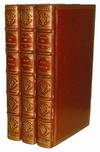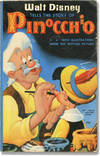![Ten Memoirs on Quantics [a complete set extracted from] The Philosophical Transactions of the Royal Society, 1854-1878](https://d3525k1ryd2155.cloudfront.net/h/733/814/1105814733.0.m.jpg)
Ten Memoirs on Quantics [a complete set extracted from] The Philosophical Transactions of the Royal Society, 1854-1878
by Cayley, Arthur
- Used
- Hardcover
- first
- Condition
- See description
- Seller
-
West Branch, Iowa, United States
Payment Methods Accepted
About This Item
London: Royal Society. 1st Edition. FIRST EDITION OF ALL 10 OF CAYLEY'S ‘MEMOIRS ON QUANTICS', a complete set extracted from 1854 to 1878 Philosophical Transactions and handsomely bound in half calf over period appropriate boards. Included are Introductory Memoir upon Quantics, 1854, 13 pages; 2nd Memoir, 1855, 25 pages; 3rd, 1856, 20 pages; 4th, 1858, 12 pages; 5th, 1858, 31 pages; 6th, 1859, 29 pages; 7th, 1861, 15 pages; 8th, 1867, 41 pages; 9th, 1870, 33 pages; 10th, 1878, 58 pages. Quantics is "a term [Cayley] coined for algebraic forms, now referred to as multilinear homogeneous algebraic forms" (Princeton).
Beginning in 1854, Cayley composed a series of 10 memoirs, the last published in 1878. For mathematicians at large, Cayley's efforts "constituted a brilliant and influential account of [quantics] theory as he and others were developing it. The results Cayley was obtaining impressed mathematicians by their unexpectedness and elegance" (DSB, III, 165).
The ‘Sixth Memoir' is the best known of the ten. In it, Cayley "laid the foundations of non-Euclidean geometry" & "demonstrated that Euclidean geometry was part of projective geometry rather than the converse" (Pierpont, "Cayley's Definition of Non-Euclidean Geometry," AJM 53, 1, 1931, 117; Princeton Companion to Mathematics, 772). Cayley's ‘Sixth Memoir upon Quantics' "contains the first analytical treatment of a projective metric from the standpoint of the algebraic theory of invariants" (Biagioli, Space, Number, and Geometry, 123).
In order to unite metrical geometry and projective geometry, Cayley introduced metrics into projective geometry by means of a fixed, embedded conic called the absolute; in other words, he introduced an ‘imaginary' element to metrical properties. "Hitherto, affine and projective geometry had been regarded as special cases of metric geometry. Cayley showed how it was possible to interpret all as special cases of projective geometry" (DSB 165).
Cayley "set himself the task of "establishing the notion of distance upon purely descriptive principle" [showing] that, with the ordinary idea of distance, it can be rendered projective by reference to the circular points and a line at infinity -- and that the same is true of angles (Bell, Men of Mathematics). "The fundamental notions in metrical geometry are the distance between two points and the angle between two lines. Replacing the concept of distance by another, also involving "imaginary" elements, Cayley provided the means for unifying Euclidean geometry and the common non-Euclidean geometries into one comprehensive theory" (Bell).
"The full significance of Cayley's ideas was not appreciated until 1871 when Klein showed how it was possible to identify Cayley's generalized theory of metrical geometry with the non-Euclidean geometries of Lobachevski, Bolyai, and Riemann. When Cayley's Absolute is real, his distance function is that of the ‘hyperbolic' geometry; when imaginary, the formulas reduce to those of Riemann's ‘elliptic' geometry. A degenerate conic gives rise to the familiar Euclidean geometry. Whereas during the first half of the century geometry had seemed to be becoming increasingly fragmented, Cayley and Klein, through the medium of these ideas, apparently succeeded for a time in providing geometers with a unified view of their subject. Thus, although the so-called Cayley-Klein metric is now seldom taught, to their contemporaries it was of great importance" (DSB 165). CONDITION & DETAILS: London: The Royal Society. All ten memoirs have been handsomely bound together in half calf over period appropriate boards. The boards are gilt-ruled; the spine, gilt-lettered. A label on the front board has been ‘aged' by our conservator as has a title page introducing the collection. The extracts themselves are bright and clean. Fine condition in every way.
Beginning in 1854, Cayley composed a series of 10 memoirs, the last published in 1878. For mathematicians at large, Cayley's efforts "constituted a brilliant and influential account of [quantics] theory as he and others were developing it. The results Cayley was obtaining impressed mathematicians by their unexpectedness and elegance" (DSB, III, 165).
The ‘Sixth Memoir' is the best known of the ten. In it, Cayley "laid the foundations of non-Euclidean geometry" & "demonstrated that Euclidean geometry was part of projective geometry rather than the converse" (Pierpont, "Cayley's Definition of Non-Euclidean Geometry," AJM 53, 1, 1931, 117; Princeton Companion to Mathematics, 772). Cayley's ‘Sixth Memoir upon Quantics' "contains the first analytical treatment of a projective metric from the standpoint of the algebraic theory of invariants" (Biagioli, Space, Number, and Geometry, 123).
In order to unite metrical geometry and projective geometry, Cayley introduced metrics into projective geometry by means of a fixed, embedded conic called the absolute; in other words, he introduced an ‘imaginary' element to metrical properties. "Hitherto, affine and projective geometry had been regarded as special cases of metric geometry. Cayley showed how it was possible to interpret all as special cases of projective geometry" (DSB 165).
Cayley "set himself the task of "establishing the notion of distance upon purely descriptive principle" [showing] that, with the ordinary idea of distance, it can be rendered projective by reference to the circular points and a line at infinity -- and that the same is true of angles (Bell, Men of Mathematics). "The fundamental notions in metrical geometry are the distance between two points and the angle between two lines. Replacing the concept of distance by another, also involving "imaginary" elements, Cayley provided the means for unifying Euclidean geometry and the common non-Euclidean geometries into one comprehensive theory" (Bell).
"The full significance of Cayley's ideas was not appreciated until 1871 when Klein showed how it was possible to identify Cayley's generalized theory of metrical geometry with the non-Euclidean geometries of Lobachevski, Bolyai, and Riemann. When Cayley's Absolute is real, his distance function is that of the ‘hyperbolic' geometry; when imaginary, the formulas reduce to those of Riemann's ‘elliptic' geometry. A degenerate conic gives rise to the familiar Euclidean geometry. Whereas during the first half of the century geometry had seemed to be becoming increasingly fragmented, Cayley and Klein, through the medium of these ideas, apparently succeeded for a time in providing geometers with a unified view of their subject. Thus, although the so-called Cayley-Klein metric is now seldom taught, to their contemporaries it was of great importance" (DSB 165). CONDITION & DETAILS: London: The Royal Society. All ten memoirs have been handsomely bound together in half calf over period appropriate boards. The boards are gilt-ruled; the spine, gilt-lettered. A label on the front board has been ‘aged' by our conservator as has a title page introducing the collection. The extracts themselves are bright and clean. Fine condition in every way.
Reviews
(Log in or Create an Account first!)
Details
- Bookseller
- Atticus Rare Books
(US)
- Bookseller's Inventory #
- 1055
- Title
- Ten Memoirs on Quantics [a complete set extracted from] The Philosophical Transactions of the Royal Society, 1854-1878
- Author
- Cayley, Arthur
- Book Condition
- Used
- Quantity Available
- 1
- Edition
- 1st Edition
- Binding
- Hardcover
- Publisher
- Royal Society
- Place of Publication
- London
Terms of Sale
Atticus Rare Books
30 day return guarantee, with full refund including shipping costs for up to 30 days after delivery if an item arrives misdescribed or damaged.
About the Seller
Atticus Rare Books
Biblio member since 2010
West Branch, Iowa
About Atticus Rare Books
We specialize in rare and unusual antiquarian books in the sciences and the history of science. Additionally, we specialize in 20th century physics, mathematics, and astronomy.
Glossary
Some terminology that may be used in this description includes:
- Calf
- Calf or calf hide is a common form of leather binding. Calf binding is naturally a light brown but there are ways to treat the...
- Title Page
- A page at the front of a book which may contain the title of the book, any subtitles, the authors, contributors, editors, the...
- Fine
- A book in fine condition exhibits no flaws. A fine condition book closely approaches As New condition, but may lack the...
- First Edition
- In book collecting, the first edition is the earliest published form of a book. A book may have more than one first edition in...
- Spine
- The outer portion of a book which covers the actual binding. The spine usually faces outward when a book is placed on a shelf....

